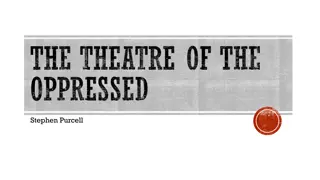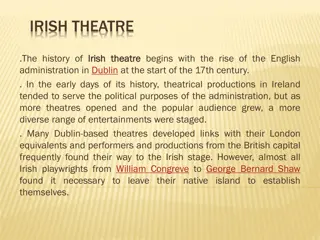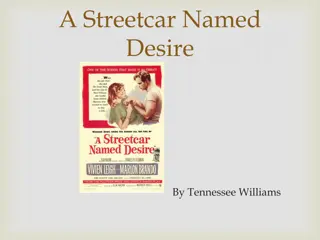Exploring Plastic Theatre in Tennessee Williams' "A Streetcar Named Desire
Tennessee Williams introduced the concept of plastic theatre in the 1940s to create a new type of theatrical experience that combined non-literary elements with the literary text. This approach aimed to enhance the themes, characters, and language of the play by integrating elements such as setting, music, sound, and visual effects. In "A Streetcar Named Desire," the importance of non-literary elements is highlighted, with vivid stage directions, symbolism, lighting, colors, costumes, props, and sound effects all playing crucial roles. Using plastic theatre techniques can convey the psychological states of characters effectively, adding depth to the overall theatrical experience.
Download Presentation

Please find below an Image/Link to download the presentation.
The content on the website is provided AS IS for your information and personal use only. It may not be sold, licensed, or shared on other websites without obtaining consent from the author. Download presentation by click this link. If you encounter any issues during the download, it is possible that the publisher has removed the file from their server.
E N D
Presentation Transcript
Plastic Theatre A Streetcar Named Desire
What is Plastic Theatre? In the early 1940s, when Tennessee Williams was working on his first successful play, The Glass Mengerie, he developed an idea he termed plastic theatre, an idea that he believed would launch a new type of theatre, that would move away from what he dismissed as typewriter theatre by affording equal value to the non-literary elements of stage production and to the literary text. ?
Rationale To express his universal truths Williams insisted that setting, properties, music, sound, and visual effects all the elements of staging must combine to reflect and enhance the action, theme, characters, and language.
Realism? Williams desired a form of drama that was more than just a picture of reality: he insists that his ideal theatre make use of all the stage arts to generate a theatrical experience greater than mere Realism.
Importance of Non-Literary Elements The visual and audible aspects of a Streetcar Named Desire are as important as the dialogue. Tennessee Williams uses these plastic elements to convey to the audience the psychological states of the characters as well as develop the themes and ideas of the play
Elements of Plastic Theatre: His vivid and evocative stage directions that help the dramatist envision the scene. Symbolism Lighting Colours Costumes Props Sound Effects-Digetic and Non Digetic
Imagine. You are a playwright. You are writing the final act of A Streetcar Name A Level ..hopefully not a tragedy!?...definitely a melodrama!? Act 3, Scene 2: The Exam Room What elements of plastic theatre would you add to convey the psychological states of the characters?
Close Analysis How, and to what effect, does Williams use elements of plastic theatre in the following scenes? Scene 3 Scene 4 Scene 6 Scene 10























